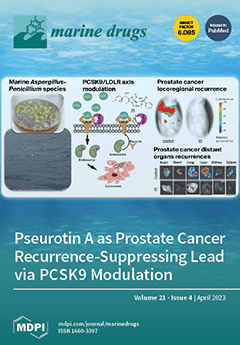Gymnodimine D (GYM D), 16-desmethyl gymnodimine D (16-desmethyl GYM D), and two tetrodotoxin analogues have been found in invertebrates obtained from the north Atlantic coast of Spain from May 2021 to October 2022. It is the first report of GYMD and 16-desmethyl GYM D in invertebrates worldwide and of the tetrodotoxin analogues, 5,6,11 trideoxy tetrodotoxin (5,6,11 trideoxy TTX) and its isomer (referred to as 5,6,11 trideoxy-epi-TTX), in the north Atlantic Coast of Spain. In this study, we also report for the first time the detection of tetrodotoxin (TTX) in three species (the cnidaria
Calliactis parasitica, an unidentified species, and the bivalve
Tellina donacina). The prevalence was medium for GYM D and 16-desmethyl GYM D and low for TTXs overall. The concentrations recorded were variable, with maximum values of GYM D in the bivalve
Cerastoderma edule (8.8 μg GYM A equivalents kg
−1), of 16-desmethyl GYM D in the bivalve
Magellana gigas (10 μg GYM A equivalents kg
−1) and of TTX and 5,6,11 trideoxy TTX in the cnidaria
C. parasitica (49.7 and 233 μg TTX equivalents kg
−1, respectively). There is very scarce information about these compounds. Therefore, the reporting of these new detections will increase the knowledge on the current incidence of marine toxins in Europe that the European Food Safety Authority (EFSA), in particular, and the scientific community, in general, have. This study also highlights the importance of analyzing toxin analogues and metabolites for effective monitoring programs and adequate health protection.
Full article






